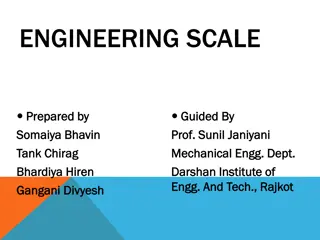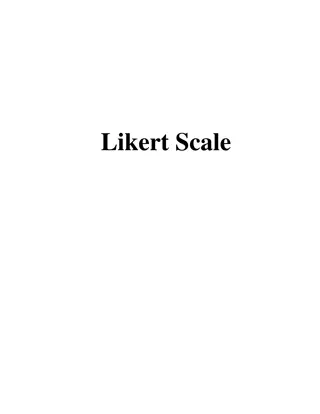Project Difficulty Scales
Difficulty scale of a project is essential for effective planning and preparation. This involves assessing the complexity levels using a scale ranging from very easy to research project or thesis level. Understanding this scale helps in gauging the effort and resources required for successful project completion. Additionally, functions, aliasing, and values play crucial roles in programming contexts, offering opportunities to enhance coding efficiency and flexibility.
Download Presentation

Please find below an Image/Link to download the presentation.
The content on the website is provided AS IS for your information and personal use only. It may not be sold, licensed, or shared on other websites without obtaining consent from the author.If you encounter any issues during the download, it is possible that the publisher has removed the file from their server.
You are allowed to download the files provided on this website for personal or commercial use, subject to the condition that they are used lawfully. All files are the property of their respective owners.
The content on the website is provided AS IS for your information and personal use only. It may not be sold, licensed, or shared on other websites without obtaining consent from the author.
E N D
Presentation Transcript
Question Question How How difficult difficult is the triplet is the triplet project on a on a scale project scale 1 1 10 ? 10 ? a) b) 2 (very easy) c) 3 (a quite standard review exercise) d) 4 (not too complicated, got some known concepts repeated) e) 5 (good exercise to repeat standard programming techniques) f) 6 (had to use more advanced techniques in a familiar way) g) 7 (quite complicated, but manageable) h) 8 (very abstract exercise, using complicated language constructs) i) 9 (very complicated barely manageable spending all my time) j) 10 (this is a research project could be an MSc thesis/PhD project) k) 25 (this is wayyy too complicated for a university course) 1 (I m offended by how trivial the project was)
Functions Functions as lambda higher-order functions map, filter, reduce as objects objects
Aliasing Aliasing functions functions both both user user defined defined and and builtin builtin Python shell > def square(x): return x * x > square | <function square at 0x0329A390> > square(8) | 64 > kvadrat = square | kvadrat(5) | 25 > kvadrat | <function square at 0x0329A390> > len | <built-in function len> > length = len > length([1, 2, 3]) | 3
Functions Functions as as values values square_or_double.py Python shell | square or double ? square | numbers: 3 6 7 9 | [9, 36, 49, 81] | square or double ? double | numbers: 2 3 4 7 9 | [4, 6, 8, 14, 18] def square(x): return x * x def double(x): return 2 * x while True: answer = input('square or double ? ') if answer == 'square': f = square break if answer == 'double': f = double break f will refer to one of the functions square and double refer to call the function f is referring to with argument x answer = input('numbers: ') L_in = [int(x) for x in answer.split()] L_out = [f(x) for x in L_in] print(L_out)
Functions Functions as as values values and and namespaces namespaces say.py def what_says(name): def say(message): print(name, 'says:', message) return say what_says is a function returning a function (say) Each call to what_says with a single string as its argument creates a new say function with the current name argument in its namespace In each call to a an instance of a say function, name refers to the string in the namespace when the function was created, and message is the string given as an argument in the call alice = what_says('Alice') peter = what_says('Peter') alice('Where is Peter?') peter('I am here') Python shell | Alice says: Where is Peter? | Peter says: I am here
Question Question What What list is list is printed printed ? ? def f(x): def g(y): a) [7, 7, 10] b) [7, 9, 8] c) [7, 9, 9] d) [7, 9, 12] e) [7, 10, 10] f) Don t know nonlocal x x = x + 1 return x + y return g a = f(3) b = f(6) print([a(3), b(2), a(4)])
map map map(function, list) applies the function to each element of the sequence list map(function, list1, ..., listk) requires function to take k arguments, and creates a sequence with the i th element being function(list1[i], ..., listk[i]) Python shell > def square(x): return x * x > list(map(square, [1,2,3,4,5])) | [1, 4, 9, 16, 25] > def triple_sum(x, y, z): return x + y + z > list(map(triple_sum, [1,2,3], [4,5,6], [7,8,9])) | [12, 15, 18] > list(map(triple_sum, *zip(*[(1,4,7), (2,5,8), (3,6,9)]))) | [12, 15, 18]
sorted sorted Python shell A list L can be sorted using sorted(L) A user defined order on the elements can be defined by providing a function using the keyword argument key, that maps elements to values with some default ordering > def length_square(p): x, y = p return x**2 + y**2 # no sqrt > L = [(5, 3), (2, 5), (1, 9), (2, 2), (3, 4)] > list(map(length_square, L)) | [34, 29, 82, 8, 25] > sorted(L) # default lexicographical order | [(1, 9), (2, 2), (2, 5), (3, 4), (5, 3)] > sorted(L, key=length_square) # order by length | [(2, 2), (3, 4), (2, 5), (5, 3), (1, 9)] https://docs.python.org/3/library/functions.html#sorted
Question Question What What list list does does sorted sorted produce produce ? ? sorted([2, 3, -1, 5, -4, 0, 8, -6], key=abs) key 2 3 1 5 4 0 8 6 a) [-6, -4, -1, 0, 2, 3, 5, 8] b) [0, 2, 3, 5, 8, -1, -4, -6] c) [0, -1, 2, 3, -4, 5, -6, 8] d) [8, 5, 3, 2, 0, -1, -4, -6] e) [0, 1, 2, 3, 4, 5, 6, 8] f) Don t know Python shell > abs(7) | 7 > abs(-42) | 42
filter filter filter(function, list) returns the subsequence of list where function evaluates to true Essentially the same as [x for x in list if function(x)] Python shell > def odd(x): return x % 2 == 1 > filter(odd, range(10)) | <filter object at 0x03970FD0> > list(filter(odd, range(10))) | [1, 3, 5, 7, 9]
reduce reduce (in (in module module functools functools) ) Python s reduce function is in other languages often denoted foldl reduce(f, [x1, x2, x3, ..., xk]) = f( f(f(x1, x2), x3) , xk) Python shell > from functools import reduce > def power(x, y): return x ** y > reduce(power, [2, 2, 2, 2, 2]) | 65536
lambda lambda ( (anonymous anonymous functions functions) ) If you need to define a short function, that returns a value, and the function is only used once in your program, then a lambda function might be appropriate: lambda arguments: expression Creates a function with no name that takes zero or more arguments, and returns the value of the single expression Python shell > f = lambda x, y : x + y > f(2, 3) | 5 > list(filter(lambda x: x % 2, range(10))) | [1, 3, 5, 7, 9]
History History of of lambda lambda in in programming programming languages languages Lambda calculus invented by Alonzo Church in 1930s At the heart of functional programming languages LISP (1958) ML (1973) and its derivatives, e.g. OCaml (1996) and F* (2011) Haskell (1990), based on Miranda (1985) C++ got lambdas with C++11 in 2011 (26 years after 1st release) Java first got lambdas with Java 8 in 2014 (19 years after 1st release) Python has had lambdas since its inception in 1994
Examples Examples: : sorted sorted using using lambda lambda Python shell > L = [ 'AHA', 'Oasis', 'ABBA', 'Beatles', 'AC/DC', 'B. B. King', 'Bangles', 'Alan Parsons'] > # Sort by length, secondary after input position (default, known as stable) > sorted(L, key=len) | ['AHA', 'ABBA', 'Oasis', 'AC/DC', 'Beatles', 'Bangles', 'B. B. King', 'Alan Parsons'] > # Sort by length, secondary alphabetically > sorted(L, key=lambda s: (len(s), s)) | ['AHA', 'ABBA', 'AC/DC', 'Oasis', 'Bangles', 'Beatles', 'B. B. King', 'Alan Parsons'] > # Sort by most 'a's, if equal by number of 'b's, etc. > sorted(L, key=lambda s: sorted([a.lower() for a in s if a.isalpha()])) | ['Alan Parsons', 'ABBA', 'AHA', 'Beatles', 'Bangles', 'AC/DC', 'Oasis', 'B. B. King'] > sorted([a.lower() for a in 'AC/DC' if a.isalpha()]) | ['a', 'c', 'c', 'd']
min and max min and max Similarly to sorted, the functions min and max take a keyword argument key, to map elements to values with some default ordering Python shell > max(['w', 'xyz', 'abcd', 'uv']) | 'xyz' > max(['w', 'xyz', 'abcd', 'uv'], key=len) | 'abcd' > sorted([210, 13, 1010, 30, 27, 103], key=lambda x: str(x)[::-1]) | [1010, 210, 30, 103, 13, 27] > min([210, 13, 1010, 30, 27, 103], key=lambda x: str(x)[::-1]) | 1010 docs.python.org/3/library/functions.html#min
defaultdict defaultdict (from An extension of the built-in dict that automatically initializes undefined items on access by calling a function (factory) to produce a default value to be inserted defaultdict(function to create default value, normal dict arguments) (from module module collections collections) ) Python shell > scores = {'Mickey': [2, 3, 1], 'Goofy': [1, 0, 2]} > scores['Gladstone'] # access to undefined key in a standard dictionary | KeyError: 'Gladstone' > from collections import defaultdict > scores = defaultdict(lambda : [], {'Mickey': [2, 3, 1], 'Goofy': [1, 0, 2]}) > scores | defaultdict(<function <lambda> at 0x0000026460F0BBE0>, {'Mickey': [2, 3, 1], 'Goofy': [1, 0, 2]}) > scores['Gladstone'] # calls lambda without arguments to initialize scores['Gladstone'] | [] > scores | defaultdict(<function <lambda> at ...>, {'Mickey': [2, 3, 1], 'Goofy': [1, 0, 2], 'Gladstone': []}) > scores = defaultdict(list, Mickey=[2, 3, 1], Goofy=[1, 0, 2]) > scores['daisy'].append(7) # calls list() to initialize scores['daisy'] > scores | defaultdict(<class 'list'>, {'Mickey': [2, 3, 1], 'Goofy': [1, 0, 2], 'daisy': [7]}) docs.python.org/3/library/collections.html#collections.defaultdict
polynomial.py Python shell | f(0) = 3 | f(1) = 5 | f(2) = 7 | p(0) = 3 | p(1) = 6 | p(2) = 11 | polynomial([3, 2, 1])(2) = 11 | h(3, 5) = 2 def linear_function(a, b): return lambda x: a * x + b def degree_two_polynomial(a, b, c): def evaluate(x): return a * x**2 + b * x + c return evaluate def polynomial(coefficients): return lambda x: sum([c * x**p for p, c in enumerate(coefficients)]) def combine(f, g): def evaluate(*args, **kwargs): return f(g(*args, **kwargs)) return evaluate f = linear_function(2, 3) for x in [0, 1, 2]: print(f'f({x}) = {f(x)}') p = degree_two_polynomial(1, 2, 3) for x in [0, 1, 2]: print(f'p({x}) = {p(x)}') print(f'{polynomial([3, 2, 1])(2) = }') h = combine(abs, lambda x, y: x - y) print(f'{h(3, 5) = }')
Question Question What value is h(1) ? What value is h(1) ? linear_combine.py def combine(f, g): def evaluate(*args, **kwargs): return f(g(*args, **kwargs)) a) 5 b) 9 c) 16 d) 21 e) 25 f) Don t know return evaluate def linear_function(a, b): return lambda x: a * x + b f = linear_function(2, 3) g = linear_function(4, 5) h = combine(f, g) print(h(1))
Namespace example Namespace example evaluate linear_combine.py lambda (f) lambda (g) args : (1,) {} def combine(f, g): def evaluate(*args, **kwargs): return f(g(*args, **kwargs)) kwargs : x : 9 x : 1 return evaluate combine g f g : f : <function lambda > <function lambda > <function evaluate > def linear_function(a, b): return lambda x: a * x + b a : b : 2 3 a : b : 4 5 evaluate: f = linear_function(2, 3) g = linear_function(4, 5) global variables h = combine(f, g) combine : <function combine > <function linear_function > <function lambda > <function lambda > <function evaluate > linear_function : print(h(1)) f : g : h :
partial (trace of computation) partial (trace of computation) partial_trace.py Python shell | new_f: fn=f, args=(7,), a=(2, 1)) | f(7,2,1) | answer=14 | g(2, 1)=14 | | new_f: fn=f, args=(2, 1), a=(3,)) | f(2,1,3) | answer=13 | h(3)=13 | | new_f: fn=new_f, args=(1, 2), a=()) | new_f: fn=f, args=(7,), a=(1, 2)) | f(7,1,2) | answer=15 | answer=15 | k()=15 > def f(x): return x > g = lambda x: x > f.__name__ | 'f' > g.__name__ | '<lambda>' def partial(fn, *args): def new_f(*a): print(f'new_f: fn={fn.__name__}, args={args}, a={a})') answer = fn(*args, *a) print(f'answer={answer}') return answer return new_f def f(x, y, z): print(f'f({x},{y},{z})') return x + 2 * y + 3 * z g = partial(f, 7) h = partial(f, 2, 1) k = partial(g, 1, 2) Python shell print(f'{g(2, 1)=}\n') # 7 + 2 * 2 + 3 * 1 = 14 print(f'{h(3)=}\n') # 2 + 2 * 1 + 3 * 3 = 13 print(f'{k()=}\n') # 7 + 2 * 1 + 3 * 2 = 15 functools.partial























